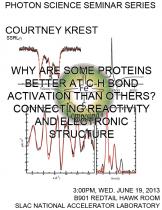Courtney Krest, SSRL
Industrial catalytic processes strive for the selectivity and efficiency that is obtained naturally by enzymatic systems. Cytochrome P450 is an enzyme found in most organisms that functionalizes C-H bonds, which is a task that is gaining significance as global oil resources are depleted. We recently trapped and characterized an important intermediate of P450 that has remained elusive for the last 40 years employing a suite of spectroscopies that included Mössbauer, electron paramagnetic resonance, and X-ray absorption that was conducted at SSRL. The measured values of exchange coupling, Fe-S bond distance, and percent radical on the thiolate ligand are compared to those of a similar chloroperoxidase (CPO) intermediate and are linked to the reactivity of C-H bond activating enzymatic systems.





